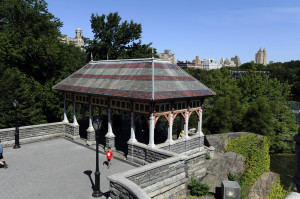
The Belvedere Castle used green materials for its rehabilitation in 1996 long before LEED was even created. Photo Credit: Jeffrey Kilmer.
The Urban Green Council, the USGBC chapter of New York City, invited me to speak about historic preservation and sustainability on Thursday, January 22nd at 6:30 in TriBeCa. They also asked me some questions. Here is part two of that Q & A.
Urban Green Council: Which project you’ve worked on to date would you describe as the absolute hardest? The one you are most proud of? –
I would say the project I am most proud of is the restoration and rehabilitation of the Belvedere Castle in Central Park. Although it was completed almost 20 years ago now, it has held up well. The project involved the restoration and adaptive use of this National Historic Landmark complex designed in 1869 by Frederick Law Olmsted & Calvert Vaux as a folly overlooking Manhattan’s original reservoir. The Castle was reinvented as a children’s discovery center and included complex technological preservation approaches due to the location of the building on a Manhattan schist outcropping overlooking a pond and the Great Lawn.

The Northwest Pavilion at the Belvedere Castle was restored with sustainably harvested wood and painted with low VOC paints in 1995, long before this was normal practice. Photo Credit: Jeffrey Kilmer
As the principal-in-charge at my previous firm Campagna & Russo Architects, I was the architect for the restoration and adaptive use of the site, implementing early sustainability approaches such as the use of low-VOC paints and coatings and natural ventilation. The project involved complete repointing, repair of spalled and cracked Manhattan schist and granite, cleaning and repair of interior slate floors and most significantly the design of new casement windows and doors in steel with operable wrought iron security grilles. The design intent of the new windows was to install durable and safe windows which would recede into the deep wall openings, harkening back to the original appearance of the open-air folly. Its successful reuse reactivated a key area of Central Park and remains one of the most highly used areas there. Every day I worked on this project I was so proud and humbled.
See more of the Q & A on the Urban Green Council webpage.
And if you’d like to “subscribe” or follow my blog, True Green Cities, please sign up through the “Subscribe” button at the bottom left of this page. You’ll receive a daily recap when new blogs are posted. Or Sign up for the Feed.
